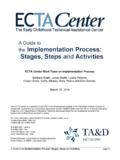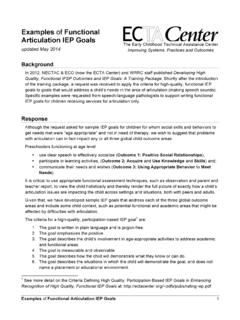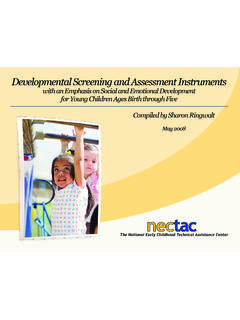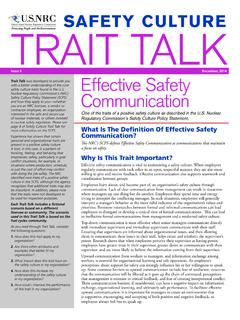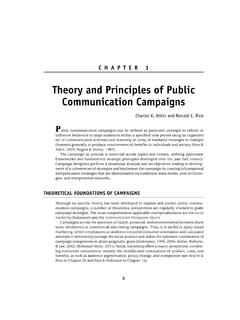Transcription of The Importance of Early Intervention - ECTA Center
1 The Importance of Early Intervention for Infants andToddlers with Disabilities and their Families July 2011. The Infants and Toddlers with Disabilities Program (Part C) of the Individuals with Disabilities Education Act (IDEA) was created in 1986 to enhance the development of infants and toddlers with disabilities, minimize potential developmental delay, and reduce educational costs to our society by minimizing the need for special education services as children with disabilities reach school Part C provides Early Intervention (EI) services to infants and toddlers aged birth to three with developmental delays or a medical condition likely to lead to a developmental delay. Part C is not intended to be a stand-alone program. The intent is to build interagency partnerships among state agencies and programs in health, education, human services and developmental disabilities.
2 WHY INTERVENE Early ? Decades of rigorous research show that children's earliest experiences play a critical role in brain development. The Center on the Developing Child at Harvard University has summarized this research: 2,3. Neural circuits, which create the foundation for learning, behavior and health, are most flexible or plastic during the first three years of life. Over time, they become increasingly difficult to change. Persistent toxic stress, such as extreme poverty, abuse and neglect, or severe maternal depression can damage the developing brain, leading to lifelong problems in learning, behavior, and physical and mental health. The brain is strengthened by positive Early experiences, especially stable relationships with caring and responsive adults, safe and supportive environments, and appropriate nutrition.
3 Early social/ emotional development and physical health provide the foundation upon which cognitive and language skills develop. High quality Early Intervention services can change a child's developmental trajectory and improve outcomes for children, families, and communities. Intervention is likely to be more effective and less costly when it is provided earlier in life rather than later. WHY ARE SERVICES ESSENTIAL? Positive Early experiences are essential prerequisites for later success in school, the workplace, and the community. Services to young children who have or are at risk for developmental delays have been shown to positively impact outcomes across developmental domains, including health,3 language and communication ,4-7 cognitive development8,9 and social/emotional ,10 Families benefit from Early Intervention by being able to better meet their children's special needs from an Early age and throughout their ,11 Benefits to society include reducing economic burden through a decreased need for special ,9.
4 WHAT ARE THE UNMET NEEDS? There is a high need for good quality Part C Early Intervention programs. More children are in need of services than are currently being served. In 2009, Part C served 348,604 children nationally, which represents of the general population of children aged birth to However, research indicates that as many as 13% of birth to 3 year olds have delays that would make them eligible according to criteria commonly used by the The National Early Childhood Technical Assistance Center 919-962-2001 phone 919-966-7463 fax web email There is a need to serve children earlier. Research has Approximately 10-11% of all newborns have shown that at 9 months of age, only 9% of children who prenatal substance exposure, 23 a risk factor for poor have delays that would make them eligible receive developmental outcomes.
5 An estimated 90-95% of services; at 24 months of age only 12% of children who these infants are sent home at birth without being would be eligible receive identified or referred for services. 23. Research also suggests that there are racial disparities In 2009, 702,000 children experienced substantiated in the receipt of EI services,13,14 with black children who abuse or neglect; 40% of these children received no would be eligible at 24 months of age being up to five post-investigation services; one third were under age times less like to receive services than white four, and infants under the age of one were the most Young children experiencing homelessness are more likely to be These young children often have likely to have lower birth weights than other children, high rates of physical, cognitive, social-emotional, learning disabilities, developmental delays, emotional relational and psychological ,26.
6 Problems and behavior issues,15-18 yet they are greatly TAKE HOME MESSAGE. underrepresented in Early childhood There is a significant shortage of well-trained There is an urgent and substantial need to identify as professionals with expertise in serving very young Early as possible those infants and toddlers in need of children with behavioral or emotional ( services to ensure that Intervention is provided when the depression, anxiety) problems19,20 that negatively developing brain is most capable of impact Early learning, social interactions, and the overall High quality Early Intervention programs for vulnerable well-being of an estimated 9% to 14% of children aged infants and toddlers can reduce the incidence of future birth to ,22 problems in their learning, behavior and health ,3.
7 IDEA requires referral to Part C for any child under the age Intervention is likely to be more effective and less of 3 who is identified as affected by illegal substance abuse, costly when it is provided earlier in life rather than or is involved in a substantiated case of child abuse or ,3. REFERENCES. 1. Individuals with Disabilities Education Improvement Act of families of children who have disabilities and participated in 2004, 20 1400 et seq. (2004). Early Intervention . Pediatrics, 116, 1346-1352. 2. Center on the Developing Child at Harvard University (2008). 12. Data Accountability Center . (2010). Part C child count: 2009. 23. National Center on Substance Abuse and Child Welfare. InBrief: The science of Early childhood development. #partcCC (2009). Substance exposed infants: State responses to the 13.
8 Rosenberg, S., Zhang, D. & Robinson, C. (2008). Prevalence problem. 3. Center on the Developing Child at Harvard University. (2010). of developmental delays and participation in Early Intervention The foundations of lifelong health are built in Early childhood. services for young children. Pediatrics, 121(6) e1503-e1509. 24. Department of Health and Human Services, Administration for Children, Youth and Families. (2010). Child _papers/foundations-of-lifelong-health/ 14. Feinberg, E., Silverstein, M., Donahue, S. & Bliss, R. (2011). maltreatment 2009. 4. American Speech-Language-Hearing Association. (2008). The impact of race on participation in Part C Early Intervention Roles and responsibilities of speech-language pathologists in services. Journal of Developmental and Behavioral Pediatrics, 25.
9 Wiggins, C., Fenichel, E. & Mann, T. (2007). Literature Early Intervention : Technical report. 32(4), 1-8. review: Developmental problems of maltreated children and 15. Department of Education. (2006). Report to the President Early Intervention options for maltreated children. 5. McLean, L. K., & Cripe, J. W. (1997). The effectiveness of and Congress on the implementation of the Education or Early Intervention for children with communication disorders. Homeless Children and Youth Program under the McKinney- 26. Barth, R. P., Scarborough, A., Lloyd, E. C., Losby, J., In M. J. Guralnick (Ed.), The effectiveness of Early Intervention Vento Homeless Assistance Act. Casanueva, C., & Mann, T. (2007). Developmental status and (pp. 349 428). Baltimore, MD: Brookes. Early Intervention service needs of maltreated children.
10 6. Ward, S. (1999). An investigation into the effectiveness of an 16. Hart-Shegos, E. (1999). Homelessness and its effects on Early Intervention method on delayed language development in children. young children. International Journal of Language & communication Disorders, 34(3), 243 264. 17. National Center on Family Homelessness. (2009). America's 7. Joint Committee on Infant Hearing. (2007). Year 2007 position youngest outcasts: State report card on child homelessness. statement: Principles and guidelines for Early hearing detection Compiled by Sue Goode, Martha Diefendorf &. and Intervention programs. Pediatrics, 120(4), 898-921. 18. National Child Traumatic Stress Network. (2005). Facts on Siobhan Colgan 8. Hebbeler, K., Spiker, D., Bailey, D., Scarborough, A.




